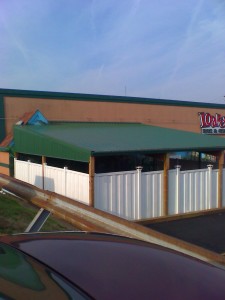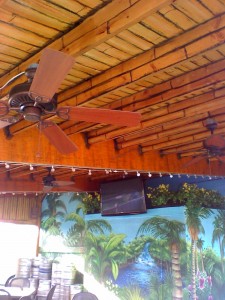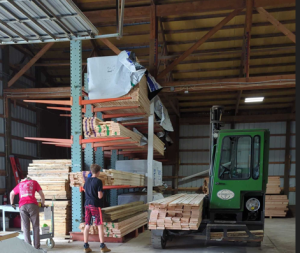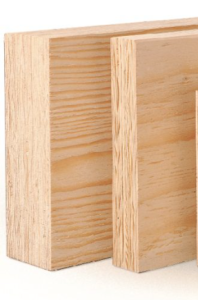 Back in 2007, we designed and provided a pole building kit package for Chris W. in North Carolina. Chris’ building is 40 foot wide by 50 feet long enclosed with a 14 foot eave height. Along one sidewall his building has a 20 foot wide roof only shed, with a 10’ low eave.
Back in 2007, we designed and provided a pole building kit package for Chris W. in North Carolina. Chris’ building is 40 foot wide by 50 feet long enclosed with a 14 foot eave height. Along one sidewall his building has a 20 foot wide roof only shed, with a 10’ low eave.
In order to achieve the maximum amount of clear height in the shed, our design utilized LVL (Laminated Veneer Lumber) for rafters to clearspan the width of the shed – without the need for prefabricated roof trusses, which would have limited vertical space.
Read more about LVLs here: https://www.hansenpolebuildings.com/blog/2013/01/lvl/
Chris has found one of my rules of pole buildings to be correct – your worldly possessions will increase to fill all available space plus 10%!
 In fact, after about 16,000 buildings, I am still awaiting the first phone call from a client to let me know their building is just too big!!
In fact, after about 16,000 buildings, I am still awaiting the first phone call from a client to let me know their building is just too big!!
Chris’ idea is to add a side shed on the opposite side, at least 24 foot wide, and perhaps as great as 40 feet!
And it CAN be done!
For Chris, or anyone else considering doing something similar, there are some design concerns. First – with a roof slope of less than 3/12 the warranty on the roof steel will be void. I feel the issue is more of one of keeping things from “sitting” on the roof panels, than anything else.
Second – Chris is not in an area prone to snow, but in snow country, the weight of snow sliding off from the main roof onto the lower sloped shed roof has to be considered.
So (in case you are wondering), how big of an LVL does it take to span the 40 feet? With snow not being a factor, my rough calculations so far indicate something around 3-1/2 inches in width by 14 inches in depth (obviously subject to review by engineering)!
Pretty amazing stuff!
 Just the other day she forwards me a photo of what appears to be an LVL which spent too much time on the beach with me in Ecuador. In lumber terms, “It is sunburned”. As Justine asked me, “Black Lumber”?
Just the other day she forwards me a photo of what appears to be an LVL which spent too much time on the beach with me in Ecuador. In lumber terms, “It is sunburned”. As Justine asked me, “Black Lumber”? Laminated Veneer Lumber (LVL) is an industry standard in framing of new wood frame buildings. LVLs are used to replace solid wood beams and joists. They are made in a process similar to plywood, where rotary peeled wood veneers (usually pine or fir) are dried then laminated together with glue and adhesive resins under heat and high pressure. Why use LVL’s? According to APA (The Engineered Wood Association – formerly the American Plywood Association) LVL is part of a broader family of products called SCL (Structural Composite Lumber). LVL is the most widely used SCL in the family. Laminated beams offer enhanced dimensional stability, along with fewer imperfections and stronger engineering properties than standard lumber. Standard widths (thicknesses) are 1 ¾ inches and 3 ½ inches. Lengths are available up to 60 feet. Standard depths are 9 ¼. 9 ½, 11 ¼. 11 7/8. 14. 16 and 18 inches. How strong is an LVL? Laminated Veneer Lumber creates structural elements which virtually never fail if used correctly. Its load capacities are precisely calculated for each use. LVL grains all run in the same direction which makes it very stiff and stable. Due to its high tensile strength it has the ability to support a great deal of weight along its length without sagging. This strength also gives the ability to span long distances without the need for posts. LVLs have high design values not only for bending, but also stiffness and shear strength. Where are LVL’s most used? In framing buildings, LVL is most often used for beams and joists. Its strength makes it good for door and window headers, stair stringers and other beams. Designed for structural applications, the surface finish is of low architectural quality. In heavier construction, they are used for support conditions requiring a high-strength lightweight member. Many companies offer engineered wood products, each with its own specific engineering properties. Does an LVL shrink or warp? As a low moisture content, factory produced product, LVLs resist shrinkage, warping, splitting and checking. Many manufacturers use sealants on their LVLs to protect from moisture damage. No special fasteners are required for assembly, LVLs installs just as easily as ordinary lumber. LVLs have no defects to cut out, reducing jobsite waste from downfall. How about saving trees? Green concerned? As LVLs use veneer rather than whole sawn timber, many trees are saved. LVL production uses wood resources efficiently as the veneers come from trees with wood otherwise considered low in quality.
Laminated Veneer Lumber (LVL) is an industry standard in framing of new wood frame buildings. LVLs are used to replace solid wood beams and joists. They are made in a process similar to plywood, where rotary peeled wood veneers (usually pine or fir) are dried then laminated together with glue and adhesive resins under heat and high pressure. Why use LVL’s? According to APA (The Engineered Wood Association – formerly the American Plywood Association) LVL is part of a broader family of products called SCL (Structural Composite Lumber). LVL is the most widely used SCL in the family. Laminated beams offer enhanced dimensional stability, along with fewer imperfections and stronger engineering properties than standard lumber. Standard widths (thicknesses) are 1 ¾ inches and 3 ½ inches. Lengths are available up to 60 feet. Standard depths are 9 ¼. 9 ½, 11 ¼. 11 7/8. 14. 16 and 18 inches. How strong is an LVL? Laminated Veneer Lumber creates structural elements which virtually never fail if used correctly. Its load capacities are precisely calculated for each use. LVL grains all run in the same direction which makes it very stiff and stable. Due to its high tensile strength it has the ability to support a great deal of weight along its length without sagging. This strength also gives the ability to span long distances without the need for posts. LVLs have high design values not only for bending, but also stiffness and shear strength. Where are LVL’s most used? In framing buildings, LVL is most often used for beams and joists. Its strength makes it good for door and window headers, stair stringers and other beams. Designed for structural applications, the surface finish is of low architectural quality. In heavier construction, they are used for support conditions requiring a high-strength lightweight member. Many companies offer engineered wood products, each with its own specific engineering properties. Does an LVL shrink or warp? As a low moisture content, factory produced product, LVLs resist shrinkage, warping, splitting and checking. Many manufacturers use sealants on their LVLs to protect from moisture damage. No special fasteners are required for assembly, LVLs installs just as easily as ordinary lumber. LVLs have no defects to cut out, reducing jobsite waste from downfall. How about saving trees? Green concerned? As LVLs use veneer rather than whole sawn timber, many trees are saved. LVL production uses wood resources efficiently as the veneers come from trees with wood otherwise considered low in quality.





